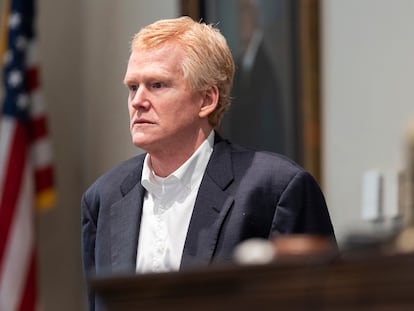What to know about Alex Murdaugh’s murder trial
More than 75 witnesses have been called and about 800 photographs, reports and exhibits have been presented as evidence

Alex Murdaugh’s family long dominated the legal scene in his small South Carolina county but for the past six weeks, Murdaugh has been on the other side of the courtroom, standing trial on murder charges in the shootings of his wife and son.
More than 75 witnesses have been called and about 800 photographs, reports and exhibits have been presented as evidence. Jurors are expected to visit the crime scene Wednesday, before both sides present their closings.
As the trial winds down, here are some takeaways:
What happened with the killings?
Alex Murdaugh called 911 on the evening of June 7, 2021, and said he’d found his son and wife dead when he returned home from a one-hour visit with his mother, who has dementia.
Authorities said Paul Murdaugh, 22, was shot twice with a shotgun, each round loaded with different size shot, while Maggie Murdaugh, 52, was struck with four or five bullets from a rifle. A crime scene report suggested both victims were shot in the head after initially being wounded near dog kennels on the Murdaughs’ sprawling rural property.
Prosecutors took more than a year to charge the disgraced lawyer with murder but decided not to pursue the death penalty. Murdaugh, who is also charged with about 100 counts of financial and other crimes, has adamantly denied any involvement in the killings. If convicted, he faces 30 years to life in prison.
What is the prosecution’s case?
Prosecutors, who contend Murdaugh killed his wife and son to distract from his financial crimes, have not presented direct evidence against Alex Murdaugh.
They called 61 witnesses and introduced more than 550 pieces of evidence over 17 days of testimony — from descriptions of the brutality of the killings to numbing details about bank records.
The weapons used to kill the victims have not been produced. But prosecutors did get one key piece of evidence that both showed Murdaugh lied to police and put him at the kennels where his wife and son were shot just five minutes before investigators think they were killed because they stopped using their cellphones.
It’s a video taken by Paul Murdaugh, locked in his cellphone for a year after the killings until federal agents could hack into it. Alex Murdaugh told the first police officer to arrive and every one after that he was never at the kennels. His voice is on that video.
“I did lie to them,” was one of the first things Murdaugh said when he took the stand in his own defense, blaming paranoia about law enforcement because he was addicted to opiates and had a bottle of pills in his pocket when he was questioned.
Star witness
Murdaugh, 54, was the 72nd witness called during the trial.
His defense team wasted no time. Their first questions were whether he killed his wife or son, which he denied forcefully. He would deny ever hurting them again and again in questions from his lawyer and cross-examination by prosecutors.
Prosecutor Creighton Waters tried one last time: “Mr. Murdaugh, are you a family annihilator?”
“You mean, did I shoot my wife and son?” Murdaugh said in a measured tone. “No. I would never hurt Maggie Murdaugh. I would never hurt Paul Murdaugh under any circumstances.”
Alex Murdaugh also admitted over and over that he lied and stole millions of dollars from his clients and his law firm. Waters detailed almost every victim and asked if he lied to their face.
“I took money that wasn’t mine. And I shouldn’t have done it. I hate the fact that I did it. I am embarrassed by it. I’m embarrassed for my son. I am embarrassed for my family,” Murdaugh said.
Murdaugh is awaiting trial for the many financial crimes he admitted to on the stand and insurance fraud charges for asking someone to kill him so his surviving son could get his $12 million in life insurance as well as tax evasion and money laundering charges.
What about the defense?
The defense has called experts who said investigators didn’t dust for fingerprints, collect and test blood, or photograph evidence with the angles or clarity needed to study it properly later.
The first officer arrived at the rural Colleton County estate 20 minutes after Murdaugh called 911. Almost immediately, the local sheriff turned the investigation over to the State Law Enforcement Division.
It took hours for agents from across the state to get deep into the South Carolina Lowcountry. During that time, more than a dozen family and friends walked around the scene, comforting Murdaugh.
The bodies of Paul and Maggie Murdaugh were covered with a sheet, which can absorb fluid, instead of a tarp. Then the sheet wasn’t saved, meaning possible hair or DNA from a killer could have been lost. Intermittent rain fell and the runoff from the kennel roof fell on Paul Murdaugh’s covered body.
When state agents arrived, they sent Murdaugh and his entourage to the home. Witnesses testified it hadn’t been searched for weapons, bloody clothes and other evidence or even checked to see if a suspect was hiding inside.
The defense also called an expert who testified the killings likely required two shooters because both Paul and Maggie Murdaugh appeared to be taken by surprise. Their hands were not raised in defense and the shockwave, blood and gore after Paul Murdaugh was shot in the head at close range with a shotgun likely would have stunned the shooter for at least several seconds and Maggie Murdaugh would have responded by running to check or running away.
Alex Murdaugh is charged with both killings, which binds prosecutors to him being the only shooter.
Sign up for our weekly newsletter to get more English-language news coverage from EL PAÍS USA Edition
Tu suscripción se está usando en otro dispositivo
¿Quieres añadir otro usuario a tu suscripción?
Si continúas leyendo en este dispositivo, no se podrá leer en el otro.
FlechaTu suscripción se está usando en otro dispositivo y solo puedes acceder a EL PAÍS desde un dispositivo a la vez.
Si quieres compartir tu cuenta, cambia tu suscripción a la modalidad Premium, así podrás añadir otro usuario. Cada uno accederá con su propia cuenta de email, lo que os permitirá personalizar vuestra experiencia en EL PAÍS.
¿Tienes una suscripción de empresa? Accede aquí para contratar más cuentas.
En el caso de no saber quién está usando tu cuenta, te recomendamos cambiar tu contraseña aquí.
Si decides continuar compartiendo tu cuenta, este mensaje se mostrará en tu dispositivo y en el de la otra persona que está usando tu cuenta de forma indefinida, afectando a tu experiencia de lectura. Puedes consultar aquí los términos y condiciones de la suscripción digital.
More information
Archived In
Últimas noticias
Petro claims the ELN was the target of US attack in Venezuela
Maduro counterattacks Trump with rhetoric and announces downing of nine drug trafficking aircraft
‘Ecce Homo’: The miraculous disaster that made a small Spanish town famous
Return to sex testing at the Olympics: IOC edges closer to banning transgender women
Most viewed
- Sinaloa Cartel war is taking its toll on Los Chapitos
- Oona Chaplin: ‘I told James Cameron that I was living in a treehouse and starting a permaculture project with a friend’
- Reinhard Genzel, Nobel laureate in physics: ‘One-minute videos will never give you the truth’
- Why the price of coffee has skyrocketed: from Brazilian plantations to specialty coffee houses
- Silver prices are going crazy: This is what’s fueling the rally










































